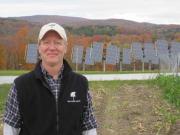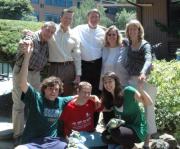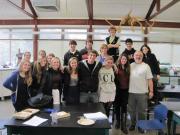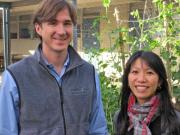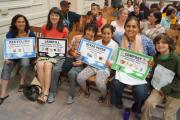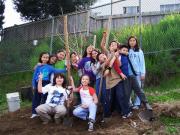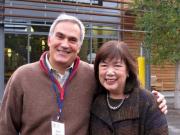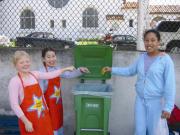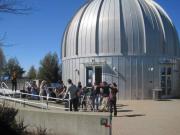Greening America’s Schools 2.0
In February 2012 NAIS published my book, Greening America’s Schools, which featured fifty case studies of schools at various stages of becoming more environmentally sustainable. Encouraged by the response to the book, and my belief that telling the story of private and public schools across the country that are “growing greener” will add momentum to this important movement, I have continued the journey. Here are four “virtual visits” I conducted with NAIS schools this year: Idyllwild Arts Academy, CA; North Country School, NY; Rabun Gap-Nacoochee School, GA; and St. Gregory College Prep, AZ. And more are on the way.
Idyllwild: The Art of Going Green
When Brian Cohen arrived as the new head of the Idyllwild Arts Academy in the summer of 2011, he saw an immediate opportunity to help the school become more sustainable. Located in what he describes as a “stunning environment” on over 200 acres at 5,300 feet in the San Jacinto Mountains above Palm Springs, California, Idyllwild Arts Academy provides pre-professional training in the full range of the arts combined with a college-preparatory high school boarding program for 295 students from around the country and the world.  In just a year, the school, along with its companion Idyllwild Arts Summer Program, has set out shape a new commitment to environmental sustainability.
In just a year, the school, along with its companion Idyllwild Arts Summer Program, has set out shape a new commitment to environmental sustainability.
For Brian Cohen, this initiative comes naturally. He moved to Idyllwild after 26 years at The Putney School in Vermont, a progressive boarding school committed to sustainability that recently constructed a LEED Platinum field house, the nation’s first zero net energy secondary school building.  Raised outside Philadelphia, he remembers wondering as a kid “where all the trash wound up” and began to get some answers when he joined the first Earth Day in 1970. Idyllwild, he notes, is situated on land that was settled after the Gold Rush, but which has been occupied by Native Americans for 5000 years. Making Idyllwild greener seemed the right thing to do.
Raised outside Philadelphia, he remembers wondering as a kid “where all the trash wound up” and began to get some answers when he joined the first Earth Day in 1970. Idyllwild, he notes, is situated on land that was settled after the Gold Rush, but which has been occupied by Native Americans for 5000 years. Making Idyllwild greener seemed the right thing to do.
Sharing his thoughts at the opening meeting faculty meetings, he sensed that environmental sustainability was a “great rallying cry” and that many people were “excited to embrace the concept.” Quickly, he assembled a team to guide the school’s efforts including the head chef, the plant director, an environmental studies teacher, as well as three key individuals. John Newman, Dean of Students, had worked for several years on environmentally sensitive campus infrastructure issues, including water and energy conservation. With a background as an Outward Bound educator, Shannon Jacobs, Student Life and Leadership Coordinator, “saw no reason why we shouldn’t do this work.”  She was joined by Jon Twichell (whose wife had worked for my school as development director), and he brought training in environmental science and experience in mass transit to a consulting position to help “shepherd the process” of evaluating the campus infrastructure.
She was joined by Jon Twichell (whose wife had worked for my school as development director), and he brought training in environmental science and experience in mass transit to a consulting position to help “shepherd the process” of evaluating the campus infrastructure.
To jumpstart sustainability initiatives, the school invited alumnus Evan Mills back to campus. An environmental energy specialist at UC Berkeley’s Lawrence Berkeley Laboratory, he spent a week at Idyllwild analyzing the plant. His PowerPoint presentation “painted a picture of things to address.”
Supported by a special foundation grant that established a fund to support sustainability projects, the school has set an ambitious course. 
The sustainability initiative is being led by six subcommittees: Buildings and Campus, Fuel and Energy, Curriculum and Education, Food, Recycling, and Marketing. With a sixty-year old campus dotted by over seventy buildings--many originally built for the summer camp--facilities are an important focus. Idyllwild Arts has established a policy to seek LEED certification for all new buildings, including a Health Center now under construction and a planned concert hall, is investigating a zero net energy house for the school head, and used Southern California Edison’s “Savings by Design” process to qualify for significant rebates. With an annual energy bill of $500,000, the school is pursuing many efforts to save, including an energy and weatherization audit, CFL retrofits, infrared energy meters to detect leaks, programmable thermostats, low-flow shower heads, and pool heating limited to summer. The school has also developed a Water Conservation Plan and is researching a Green Purchasing Policy. Students and faculty have begun to work together on campus sustainability initiatives, launching a new recycling program, transitioning to a “trayless” dining hall, and transitioning to local, organic food. 
Idyllwild has clearly envisioned a different future for the school, one that builds on its beautiful environment and prepares young artists for creative careers, informed by a sense of civic responsibility and stewardship of their surroundings.
North Country School: An Environmental Education School
The mission of North Country School, a boarding school enrolling 90 students in grades 4 to 9 on 200 acres in the beautiful Adirondacks near Lake Placid, includes an elegant expression that environmental sustainability is a central purpose: “We are committed to simple and sustainable living, making responsible choices about our use of resources.” After Camp Treetops was founded in 1921, North Country School was established in 1938 by progressive educators steeped in John Dewey’s philosophy of education that children learn best through experience. Today North Country School, with its affiliated camp, has refined that vision to incorporate desire to “educate toward sustainability” in all aspects of the school’s operations and program.
Today North Country School, with its affiliated camp, has refined that vision to incorporate desire to “educate toward sustainability” in all aspects of the school’s operations and program.
It is clear the leadership of the school embraces the desire to foster a culture of sustainability. As the Board of Trustee declares in the school’s Statement on Sustainability, “We believe three broad strands, often interwoven, constitute the basis for the sustainability of good life on Earth--appreciation and protection of resources, both natural and human-made, promotion of physical and emotional health, and working toward peaceful interactions in our community and beyond.” I was fortunate to know the Head of School, David “Hock” Hochschartner, when he was Director of Presidio Hill School in San Francisco more than a decade ago, and I can see how his passion for the environment is inspiring the school toward important changes. Importantly, he is responsible for reporting regularly to the Board on “the degree to which we adhere to sustainability practices” in curriculum, professional development, and operation of the school.
John Culpepper, Director of Facilities and Sustainability, leads the school’s efforts to model best practices in using resources efficiently and operating the school in a healthy fashion.  Raised in East Tennessee, he grew up spending time outdoors, prompting him to study ornamental horticulture, landscape design, molecular genetics at the University of Tennessee, where he received his B.S. and M.S., as well as additional graduate work in “pomology,” the science of fruit tree cultivation, at Cornell University. With this extensive training, John came to NCS in 1990 to head the garden program, and since then has spearheaded a variety of initiatives to reduce the school’s carbon footprint. The school has an extensive recycling program, composts 100,000 lbs of green waste and animal manures annually, and uses green cleaning products. Recently, he also has overseen the construction of an 8,000 square foot zero net energy student-staff residence.
Raised in East Tennessee, he grew up spending time outdoors, prompting him to study ornamental horticulture, landscape design, molecular genetics at the University of Tennessee, where he received his B.S. and M.S., as well as additional graduate work in “pomology,” the science of fruit tree cultivation, at Cornell University. With this extensive training, John came to NCS in 1990 to head the garden program, and since then has spearheaded a variety of initiatives to reduce the school’s carbon footprint. The school has an extensive recycling program, composts 100,000 lbs of green waste and animal manures annually, and uses green cleaning products. Recently, he also has overseen the construction of an 8,000 square foot zero net energy student-staff residence.
Impressively, North Country School has demonstrated that being green means saving money. For example, Culpepper determined that the school uses 1.5 million KWH annually to heat the buildings and he led the effort to install a biomass plant that he estimates will save between $23,400 and $71,000 a year, depending on the price of the fuel they would have had to purchase and the type of biomass used (purchased pellets or wood chips from the property); he calculates the return on the school’s net investment of $90,000 (after stimulus rebates) between 3.8 and 1.3 years.  On a smaller scale, he installed a $10 KW photovoltaic system that saves the school $800 a year. Reflecting on the “green triple bottom line,” he observes: “In terms of cost savings over time, each initiative is unique. Some initiatives have a very rapid ROI, while other initiatives offer no discernible monetary savings (but may have significant positive implications on enrollment, staff hiring and retention, and development efforts).”
On a smaller scale, he installed a $10 KW photovoltaic system that saves the school $800 a year. Reflecting on the “green triple bottom line,” he observes: “In terms of cost savings over time, each initiative is unique. Some initiatives have a very rapid ROI, while other initiatives offer no discernible monetary savings (but may have significant positive implications on enrollment, staff hiring and retention, and development efforts).”
The heart of a school is its program and education of the students, and North Country School appears to have a solid commitment to nurturing environmental literacy.  An obvious strength is the historic farm and garden program, one that allows students to learn through first-hand experience about nature’s systems and to produce food that is used directly in the campus food program.
An obvious strength is the historic farm and garden program, one that allows students to learn through first-hand experience about nature’s systems and to produce food that is used directly in the campus food program.  The setting gives students and faculty ample opportunity to pursue healthy activities like skiing and hiking and campus responsibilities like cleaning the barns and caring for the animals.
The setting gives students and faculty ample opportunity to pursue healthy activities like skiing and hiking and campus responsibilities like cleaning the barns and caring for the animals.
In my “virtual tour” of North Country School, I had an opportunity to speak with Director of Communications John Nicholson about what drew him to the school, where he worked as a counselor at Camp Treetops as an undergraduate at Wesleyan University.  After a “30 year hiatus” working for a consulting firm, as the founder and CEO of an event planning and production company, and most recently in the technology industry, and with a young family in Chicago, he decided to balance the pace of modern life by returning to the land. There is probably no better validation for the worth of a school than having employees join in part to ensure the good education of their children. For the families connected with the school, North Country School is offering their students an environmental education in a beautiful setting and will surely help attune them to nature and sustainability.
After a “30 year hiatus” working for a consulting firm, as the founder and CEO of an event planning and production company, and most recently in the technology industry, and with a young family in Chicago, he decided to balance the pace of modern life by returning to the land. There is probably no better validation for the worth of a school than having employees join in part to ensure the good education of their children. For the families connected with the school, North Country School is offering their students an environmental education in a beautiful setting and will surely help attune them to nature and sustainability.
Rabun Gap-Nacoochee School: From Foxfire to Environmental Sustainability
In 1966 a new teacher at the Rabun Gap-Nacoochee School in northeastern Georgia was searching for a way to make learning English more relevant for his students. With them he created what came to be known as the Foxfire Project. By interviewing their families and neighbors, the students discovered the lore, culture and environment of the Southern Appalachian Mountains. Over time the project, which produced a magazine and 12 books, influenced a generation of teachers, myself included, to incorporate into their classes engaging lessons based on real-world issues and the investigation of local and family history. Today the legacy of the Foxfire Project lives on at the school in the form of a reinvigorated commitment to environmental sustainability.
The Rabun Gap-Nacoochee School was established in 1903 “to help educate and give hope to the isolated people of the region.” Students took classes, worked on the school farm growing and preparing their food, and maintained the school's buildings. The school has evolved to become a strong college-preparatory day-boarding academy for 350 students from more than a dozen states; with 25% of the students from other countries the school has a strong global culture. Located on 1400 acres, the school includes environmental and outdoor education opportunities
In recent years Rabun Gap-Nacoochee School has recognized that environmental sustainability is both deeply imbedded in the school’s culture and an area for renewed focus. One of the key leaders of that effort is long-time faculty member and Science Department Chair Woody Malot who helped to develop the Environmental Stewardship Program and it was good to meet him in my “virtual tour” of the school. Raised in coal-mining country in rural Pennsylvania, he early on developed a love of nature and has enjoyed many memorable hikes on the Appalachian Trail. After getting his teaching certificate from Western Carolina University, he joined the faculty in 1990 to teach science. Through his personal initiative the school has developed and incorporated a wide-range of sustainability projects. The school has: calculated the carbon footprint and installed solar PV cells, built a biodiesel manufacturing system using cooking oil from the dining hall, produced fuel grade ethanol from a variety of waste streams on campus, installed geothermal heating and air handling systems for two residential halls, converted an old pump house to a hydroelectric plant, implemented an extensive recycling program supported by a bailer to compact the waste, begun a vermiculture, worm compost program to convert food scraps into soil, initiated a comprehensive land use project to map the school ecosystem, and launched the Eco-Olympic student competition to drive down waste. Importantly, all of these projects have been completed by students as part of their educational program!
Looking to the future, the Board of Trustees approved in Spring 2011 a new plan called “Beyond Sustainability – Revealing the 21st Century learner’s ability to make a difference in the environment.” The plan calls upon the school to deepen its “commitment to sustainability practices” by integrating initiatives related to the curriculum development, local food production, land management, conservation, and alternative energy. The plan also seeks to reinvigorate the work program as a means for students to help realize the vision for sustainability.
In Spring 2012 the school developed a plan to implement the new sustainability program. A key element appears to be the creation of a new Sustainability Director position. With school head Anthony Sgro, Upper School Head David Landis, and Woody Malot behind the project, the leaders of Rabun Gap-Nacoochee School are well poised to take the school to the next level and become a local, regional and national model of systemic change. With their success the leaders of Rabun Gap-Nacoochee School will be following in the footsteps of the Foxfire Project.
St. Gregory College Prep: Green Innovation
When Jonathan Martin became head of St. Gregory College Prep, a 6-12 school with 300 students in Tucson, Arizona, he wondered how the could “leverage its position to become more sustainable.” A student of innovation, Jonathan has spoken frequently about the change process in schools and hosts a well-regarded blog on educational issues (www.21k12blog.net).  By asking the right questions, and assembling a good team, he has begun to create a culture of green innovation at his school. I have known Jonathan for years since he headed several San Francisco Bay Area schools, and it was good to reconnect with him this winter at NAIS and arrange for a “virtual tour” of his school.
By asking the right questions, and assembling a good team, he has begun to create a culture of green innovation at his school. I have known Jonathan for years since he headed several San Francisco Bay Area schools, and it was good to reconnect with him this winter at NAIS and arrange for a “virtual tour” of his school.
He began that effort by helping to redraft the school’s mission to embrace “excellence in character, scholarship, leadership, and innovation” and to produce a description of innovation
as a core value: “We cultivate a mindset of innovation founded upon open-minded inquiry, divergent thinking, and purposeful action. As innovators, our students develop the creativity, ingenuity, inventiveness, and originality of thought to tackle and resolve the challenges facing our world.”  Fortunate to have attended schools that fired his imagination—Milton Academy, Sidwell Friends, Harvard, Starr King School for the Ministry and the University of San Francisco—he has put that learning to good use studying “how school-leaders can better facilitate curricular innovation by teachers.” His special interest in environmental sustainability, he says, was developed while sailing as a kid on Hingham Bay in Massachusetts, where people “frowned at motor boats and their use of fossil fuels.”
Fortunate to have attended schools that fired his imagination—Milton Academy, Sidwell Friends, Harvard, Starr King School for the Ministry and the University of San Francisco—he has put that learning to good use studying “how school-leaders can better facilitate curricular innovation by teachers.” His special interest in environmental sustainability, he says, was developed while sailing as a kid on Hingham Bay in Massachusetts, where people “frowned at motor boats and their use of fossil fuels.”
A significant first step for Jonathan Martin in greening St. Gregory was hiring a new CFO, Rick Belding, an experienced school head with a great deal of financial acumen. Martin asked Belding to look for innovative projects, beginning with the replacement of old air conditioning in the gym as a first priority. “He mentioned looking for more sustainable solutions than 125 tons of air conditioning,” Belding recalls. With their leadership, St. Gregory installed a 140 kW, 600 panel solar system using a Power Purchase Agreement and benefiting from the local power company’s mandate to develop incentives for renewable power. 
Jonathan Martin could see important ways to engage students in helping the school address its goal to become more energy efficient. The curriculum now includes a course called Design/Build Technology Innovation, taught by physics instructor Dennis Conner to help students develop 21st century skills, like problem solving and creative thinking. One group of students recognized that after St. Gregory had become a one-to-one laptop school, there was a spike in electricity demand. Their solution? Install solar panels on a maintenance shed and build a “ramada” shade structure adjacent to it where students could plug in their electronic devices. With $800 of school support, the student team implemented the project and became active participants in the sustainability effort.
Another priority for Martin at St. Gregory has been building a greater private-public partnership with the local community, which led to the One School, One City initiative.  A team charged with reviving the school’s program that had become dormant recommended that it be re-launched with a new project-based focus. The Parents Association set up a small grant program to provide an incentive for innovative projects. The students’ interest in the environment found an immediate outlet, as is evident from the several projects they have created to: build a community garden in the 6th grade courtyard; sponsor presentations about desert biodiversity by The Sonoran Desert Museum; establish a water harvesting system on the Middle School campus; partnering with Tucson’s Audubon Society and other members of the community to grow native plants from seed on campus; and installing a 400 watt wind turbine power generator at the laptop charging ramada.
A team charged with reviving the school’s program that had become dormant recommended that it be re-launched with a new project-based focus. The Parents Association set up a small grant program to provide an incentive for innovative projects. The students’ interest in the environment found an immediate outlet, as is evident from the several projects they have created to: build a community garden in the 6th grade courtyard; sponsor presentations about desert biodiversity by The Sonoran Desert Museum; establish a water harvesting system on the Middle School campus; partnering with Tucson’s Audubon Society and other members of the community to grow native plants from seed on campus; and installing a 400 watt wind turbine power generator at the laptop charging ramada.
This kind of innovative spirit also let St. Gregory to create a one-acre garden on campus with 35 to 40 plots that are maintained by members of the local community.  Half a dozen St. Gregory faculty members have plots and have begun to incorporate the campus farm into the curriculum. The Latin class grows heirloom seeds as in Ancient Rome and the P.E. classes use the garden as part of the health and wellness curriculum. Eventually, the school hopes to provide produce directly to the campus dining hall.
Half a dozen St. Gregory faculty members have plots and have begun to incorporate the campus farm into the curriculum. The Latin class grows heirloom seeds as in Ancient Rome and the P.E. classes use the garden as part of the health and wellness curriculum. Eventually, the school hopes to provide produce directly to the campus dining hall.
From small seeds great innovation can grow. It is clear that with Jonathan Martin’s leadership, St. Gregory has begun to more toward a vision of environmental sustainability, one that harnesses the creative imagination of the community.
